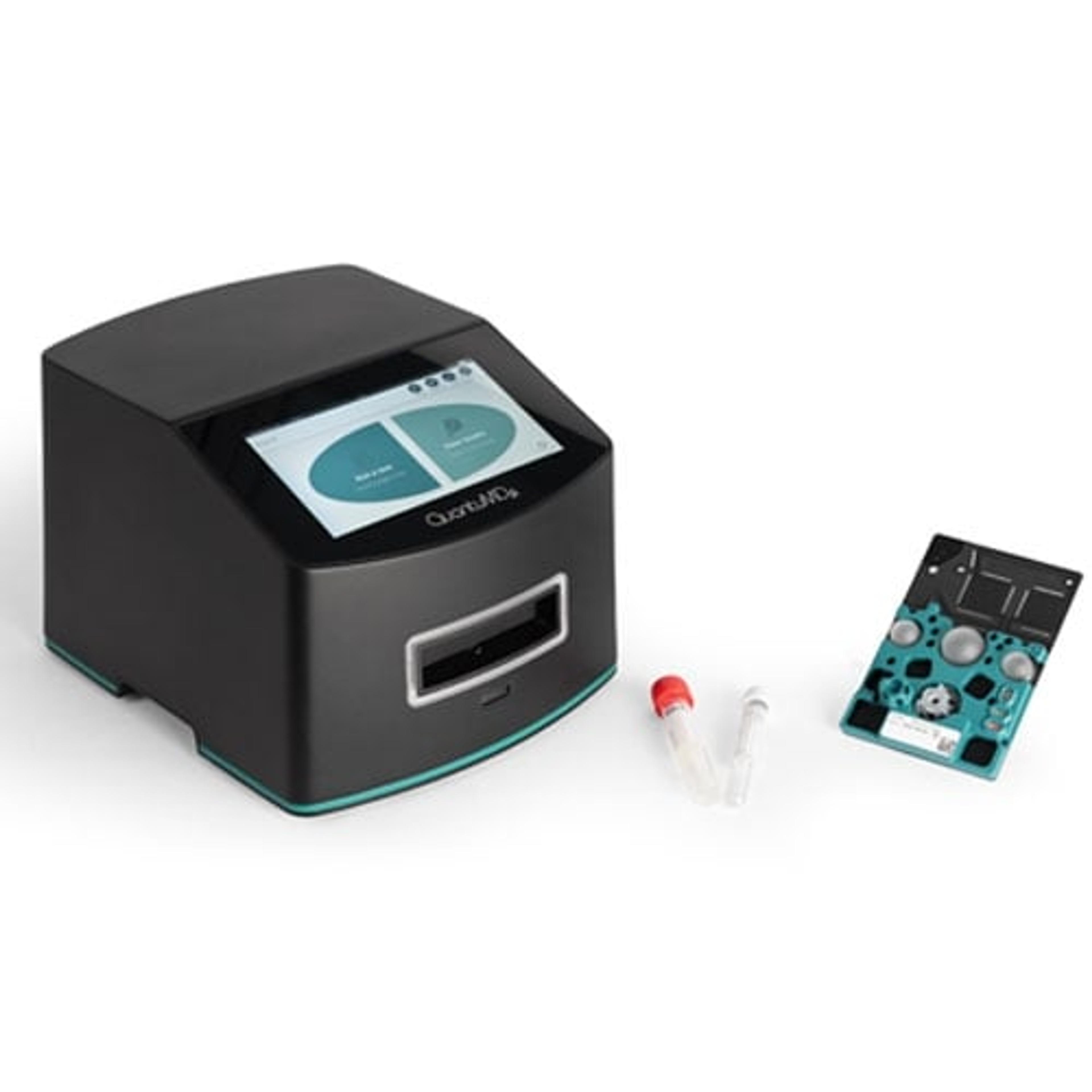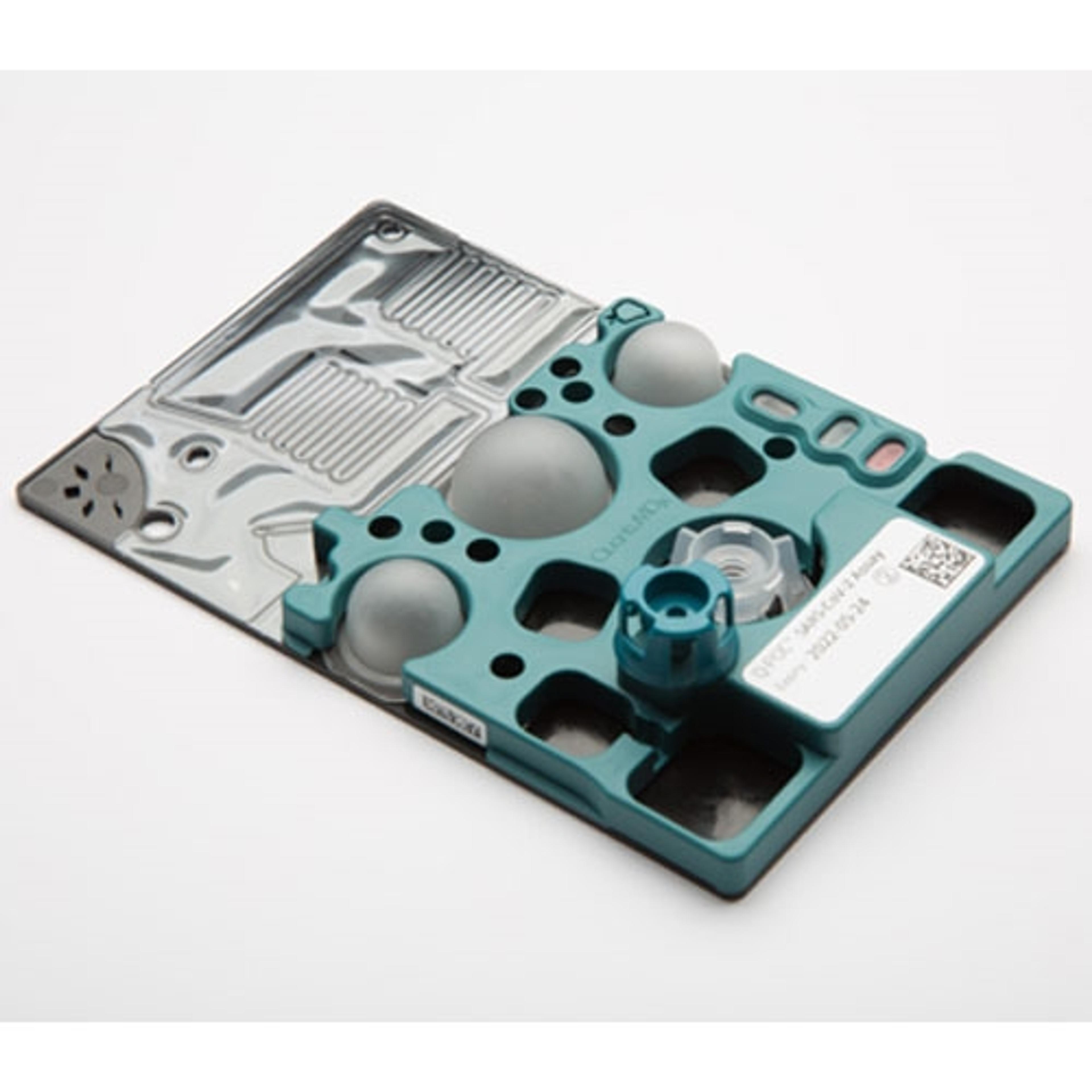Meet the pioneers leading change in Point-of-Need PCR testing
Inventor at QuantuMDx reveals how his device is transforming the way we diagnose disease with advanced multiplexing technology, and uncovers how it will ease pressures on the NHS to deliver quality healthcare to all
26 Jun 2022

Diagnostic tools serve to deliver vital information to clinicians, aiding them to provide a definitive diagnosis and appropriate treatment and/or management plan to a patient. When a diagnosis is made in an accurate and timely manner, the patient has the best opportunity for a positive health outcome, which is essential for the provision of quality care. After all, we must first identify a disease, before we can even begin to treat or manage it. Technological and scientific breakthroughs have allowed state-of-the-art diagnostic devices to be explored and developed. These specialized tools have been designed to detect disease presence with more accuracy and speed than ever before. These advances have led to more clinicians gaining direct access to high-quality diagnostic results in less time, enabling clinicians to administer treatment quickly, whilst feeling confident in their clinical decision making.
In this exclusive SelectScience interview, we speak with Johnathan O’Halloran, Chief Executive Officer at QuantuMDx, to find out more about the importance behind delivering an accurate diagnosis, and how his team of scientific experts worked together to build the Q-POC™, a portable and simple-to-use platform created to diagnose disease in as little as 30 minutes. O’Halloran also explores the growing prevalence of flu, reveals how the Q-POC™ has the potential to multiplex and directly impact busy health care workers, and shares his aim to soon dominate the field of clinical diagnostics.
Shaping the future of precision diagnostics
Delivering an accurate and timely diagnosis is the essential first step in achieving optimal patient outcomes. Since a diagnosis is the basis of any treatment plan, access to a reliable and sensitive diagnostic device is critical. A slow and incorrect diagnosis will inevitably lead to treatment delays, ineffective treatments, and will negatively impact overall patient health and wellbeing. When the patient’s condition is not visually detectable during a physical examination, these powerful diagnostic devices – which use clinical samples, such as blood or saliva to reveal much more valuable information about the patient – are vital.
To help tackle this issue, Jonathan O’Halloran, inventor, and CEO of QuantuMDx, became fascinated with molecular diagnostics over 20 years ago. “I started QuantuMDx by building a lab in my garage, which I worked in for around nine months. My aim was to create a device that could turn around results quickly, without the need to do everything by hand,” explains O’Halloran. “I managed to generate lots of data, and I was able to secure funding from South Africa. During this time, we moved to Cape town, where we worked hard to gather more data, and further develop the company. We soon had all the building blocks pretty much sorted, and it was then a case of integrating everything together.”
From then on, O’Halloran and his expert team joined forces with Sir John Burn, now chairman of QuantuMDx. Sir John offered lab space to the team in Newcastle, United Kingdom, where they have continued to stay, and have secured more funding to expand the company further. “Once the pandemic hit, we had built our molecular diagnostic device, but it wasn't ready for prime time. It needed further development, and we needed to scale it up for manufacture. Fortunately, there was a lot of money available for accelerating this kind of technology, and we were fortunate enough to receive a grant to enable us to progress,” says O’Halloran. By the end of 2020, QuantuMDx had three manufacturing sites capable of producing millions of tests per year. It was also at this time that the company had initiated their first clinical trial with the NHS. “2020 was the most amazing year for us. We were working through the pandemic. Our team was literally working night and day, including weekends, to get this device out. What would have normally taken three years, we managed to achieve in about seven months, which was incredible,” shares O’Halloran. QuantuMDx is now a progressive medical technology company, pioneering multiplex diagnostic solutions for real-world problems via rapid PRC solutions for Point-of-Need.
Multiplexing: Emerging technologies for Point-of-Need testing
O’Halloran leads a team of scientific experts, who have been working tirelessly to develop the Q-POC™. The Q-POC™ is a rapid, high-quality, Point-of-Need multiplex PCR testing device. The Q-POC™ platform is a portable and simple-to-use platform, designed to deliver fast, accurate, and actionable results in approximately 30 minutes at any location. Following the success of the Q-POC™, the team developed the Q-POC™ SARS-CoV-2 assay, and then, “building on from the Q-POC™ SARS-CoV-2 assay, we've now developed a new assay using exactly the same cassette that goes into the Q-POC™ device, but with a newly developed chemistry that enables us to multiplex. This means we can run lots of different tests on the same patient sample at the same time,” states O’Halloran. “This multiplex test not only allows us to detect SARS-CoV-2, but now flu A, flu B, and respiratory syncytial virus (RSV) A and B. This is really important because SARS, flu, and RSV all present exactly the same way, such as a patient presenting with a fever, cough, and running nose. Therefore, for a clinician or a triage nurse to differentiate between these three diseases based upon clinical presentation is impossible. The only way to establish the correct diagnosis is to do a diagnostic test,” says O’Halloran.
Traditional diagnostic methods often require the need to obtain a sample from a patient and send the sample to the lab for further analysis, a process which can take up to eight hours. Another popular option is to run a series of lateral flow tests, one after the other, or a series of loop-mediated isothermal amplification (LAMP) tests. These traditional processes can take time to generate a result, and the cost associated with these tests do increase with each test that they run. “Now you can just run a Q-POC™. All you need is a single test from a single swab, and this will take 30 minutes or so to deliver a differential diagnosis at a very high accuracy rate. The ability to rapidly triage patients is key,” says O’Halloran. Speaking directly about the importance of diagnostic speed, O’Halloran states, “information is power, and if you've got access to rapid information, then it is even more powerful. The sooner you are able to stratify patients into the right disease group, the sooner you can treat them, and the less chance they will have of transmitting disease to people with other diseases to prevent co-infection.” In addition to this, there are even more benefits to diagnosing disease early, “there’s a lot of evidence now that shows treating flu and RSV has much better outcomes if you can begin treatment early. The sooner you can diagnose, the better the outcome is,” explains O’Halloran. The advanced technology behind the development of the Q-POC™ has encouraged distributors across the globe to sign up. “Our respiratory panel has started to attract lots of interest, the sky’s the limit from this moment on,” states O’Halloran.
Despite the growing success of QuantuMDx, competing with other diagnostic world leaders is an obstacle for any thriving company, which the QuantuMDx team have already overcome. “For us as a company, there's a lot of competition in the SARS-CoV-2 space. During the pandemic, there was a huge explosion of different technologies and assays to diagnose SARS-CoV-2. However, there are very few that are able to multiplex, and to expand into performing other assays at the same time,” shares O’Halloran. The unique ability to multiplex transforms the company from an area of high competition to very low competition. “The Q-POC™ was always developed and designed to do multiplexing tests, not just for syndromic panels, like our respiratory panel, but also for the other pandemic bubbling along in the background, which is antimicrobial resistance. Therefore, this product is super important to us as a business because it acts as an example to demonstrate the power of multiplexing, something that's just not available at the moment for Point-of-Need,” reveals O’Halloran.
Flu: Making a comeback after the pandemic
When asked what he predicts might happen with flu A, B and RSV this autumn and winter following the COVID-19 pandemic, O’Halloran states, “last winter we expected that there would be a flu or an RSV rebound, and to an extent there was. Interestingly, whilst we are released from lockdown, a lot of countries in the Southern hemisphere have been in severe lockdown for a very long time. Therefore, the rebound didn't happen last winter as we thought it might do, but now we're seeing a lot of Southern hemisphere countries released from lockdown, and suffering with more flu.” O’Halloran continues, “We know that an epidemic is bubbling. Whether or not it'll come this winter, we don't know, but the flu rates are increasing significantly.” The increase prevalence of flu is showing that there is a lack of immunity within the community that is driving this atypical increase in flu, which is out of its normal seasonal patterns. I think it's going to be very wise for the NHS and private healthcare sectors to really take this rebound seriously. We are likely going to see another spike in COVID-19 cases, which will be further compounded by flu and RSV,” explains O’Halloran.
In May 2022, the company launched the Q-POC™ SARS-CoV-2, Flu A/B & RSV Assay, a respiratory panel test to help in the fight against respiratory disease. This assay has been designed to provide trusted and rapid results at the Point-of-Need, which requires minimal training and hands-on time, and can be used in virtually any clinical or non-clinical setting.
Fortunately, the Q-POC™ has the potential to positively impact our busy healthcare providers, which now face the complex job of differentiating between these three diseases, flu A, B, and RSV. “When healthcare providers had to differentiate between two diseases, it was relatively simple because you could just test for flu and if it wasn't flu, then that child probably had RSV. Now, we have three, which is a significant challenge, because you will treat each one of those differently, yet they all present the same, and the doctor needs to initial treatment quickly.” Unfortunately, being able to initiate treatment quickly is challenging using the current traditional methods, since it can take eight hours to retrieve a result. “Now, with the Q-POC™, a patient will be swabbed, the sample will be placed in the Q-POC™, and 30 minutes later, we've got a differential diagnosis. That patient can be stratified into the right treatment algorithm and segregated into a COVID-19 ward, flu ward or into the RSV ward.” O’Halloran explains that the Q-POC™ has the potential to free up primary healthcare by offering these rapid panel tests, which enables a nurse to triage patients visiting the practice and is able to identify if the patient has a common cold or if it is a respiratory disease that warrants seeing the doctor.
Not only does the Q-POC™ alleviate pressures on NHS staff, but the Q-POC™ is easy to use and can be operated anywhere, “one of the best things about Q-POC™ is it's super simple to use. The ease of use is important, particularly for those working within an ICU or emergency department. I've had my 11-year-old niece run a device without any problems and with very little instruction. The user has to load the sample in the cassette, place the cassette in the Q-POC™ and press go. We’ve got these devices all over the place, such as with oil rigs and movie sets, which really speaks to how easy these things are to use, and the fact that they're battery operated and portable, rather than having to take the sample to the device. The flexibility is inherent in the design of the device.”
Future aims
Looking to the future, O’Halloran shares his excitement for global domination within the field of multiplex Point-of-Need diagnostics. “We feel very strongly that syndromic panels are the future. It really does help doctors and also really helps communities without doctors to provide the differential diagnosis, which is incredibly important when thinking about how to stratify patients into different treatment groups.” As the QuantuMDx team accelerate forward in their mission, they’ll be soon able to group diseases together, such as gastric disease, diarrhea, hepatitis, and meningococcal-based disease. “With these groups, we can create panels that will test for everything that will cause a certain symptom. This means that we will be able to decentralize diagnosis significantly. By doing this, we take the pressure off very busy labs and hospitals and improve the patient experience significantly because early diagnosis results in better outcomes.”
Looking further ahead, the talented team at QuantuMDx will be exploring the inclusion of drug-resistant mutation screens on their pathogen ID panels. This will mean that patients can be initiated on the right therapy first time, to improve patient experience and limit treatment failure due to resistance. In turn, this improves the cost-saving to the healthcare system, without the need to waste precious drugs, and prevent further transmission or drug-resistant diseases. This is because the doctor will be treating the patient at the right time with the right drug. “Everything starts with diagnosis, and we feel that the Q-POC™ platform is the one for the future,” O’Halloran concludes.



